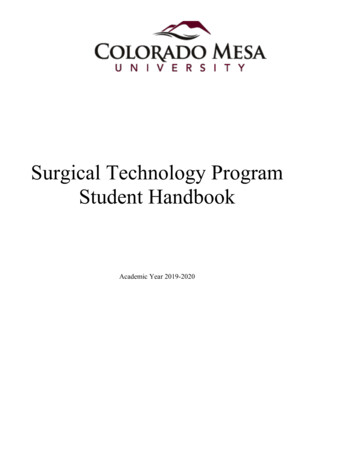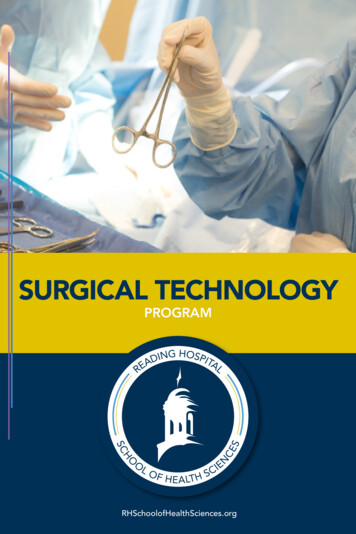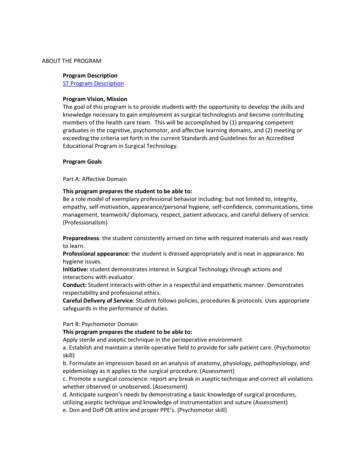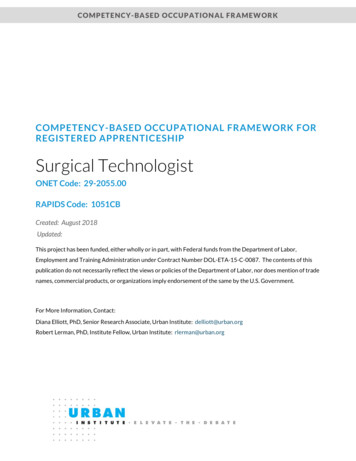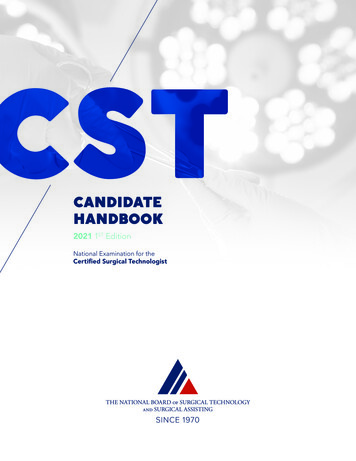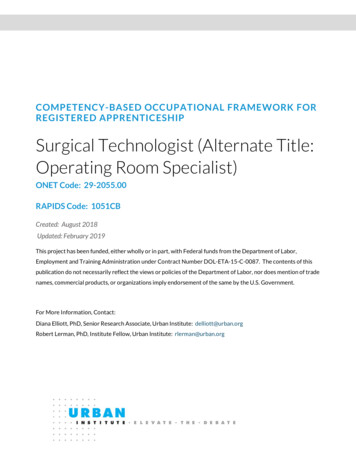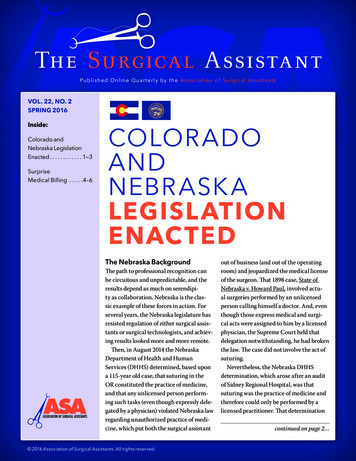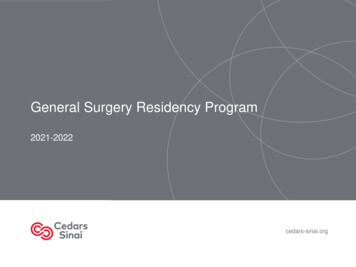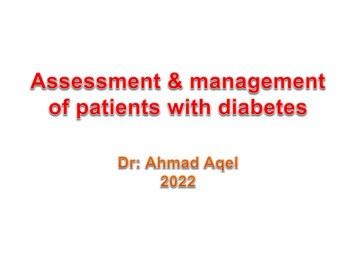
Transcription
DiabetesIntroduction: A group of diseases characterized by hyperglycemiacaused by defects in insulin secretion, action, or both DM consequences Physical, social, and economic consequences A leading cause of non-traumatic amputations,blindness, and end-stage kidney disease (ESKD). A leading cause of death from disease (MI, stroke,and peripheral vascular disease).
Functions of Insulin Transports and metabolizes glucose for energy Stimulates storage of glucose in the liver andmuscle as glycogen Signals the liver to stop the release of glucose Enhances storage of fat in adipose tissue Accelerates transport of amino acids into cells Inhibits the breakdown of stored glucose, protein,and fat
Classifications of Diabetes1. Type 1 diabetes (insulin dependent)2. Type 2 diabetes ( non insulin dependent)3. Gestational diabetes (usually on 2nd and 3rd trimester)4. Diabetes associated with other conditions (e.g.,pancreatic diseases, hormonal abnormalities,medications such as corticosteroids ) Prediabetes: impaired glucose tolerance (IGT) orimpaired fasting glucose (IFG)
Type 1 Diabetes Beta cells (Insulin producing) destroyed by anautoimmune process Requires insulin (little or no insulin is produced) Onset is acute and usually before the age of 30 y Represent 5-10% of diabetic patients. If glucose 80 to 200 mg/dL, the kidneys may notreabsorb all of the filtered glucose; the glucose thenappears in the urine called glycosuria.
Type 2 Diabetes Decreased sensitivity to insulin (insulin resistance) andimpaired beta cell function result in decreased insulinproduction 90% to 95% of person with diabetes. Onset over 30 years age, increasing with obesity Slow, progressive glucose intolerance Treated initially with diet and exercise Oral hypoglycemic agents initially may need toconvert to insulin or use both
Type 2 Diabetes Insulin resistance may also lead to metabolicsyndrome, which is a constellation of symptomsincluding hypertension, hypercholesterolemia,abdominal obesity, and other abnormities Onset of type 2 undetected for many years becauseit is associated with a slow, progressive glucoseintolerance.
QuestionIs the following statement true or false?Type 1 diabetes is treated initially with dietand exercise.
Gestational Diabetes Glucose intolerance, onset during pregnancy. Secretion of placental hormones causes insulinresistance. Occurs in 18% of pregnant women. Risk factors: marked obesity, Hx of gestationaldiabetes, glycosuria, or family history of diabetes.
DM Clinical Manifestations “Three Ps”1. Polyuria (excessive urine)2. Polydipsia (excessive thirst)3. Polyphagia (excessive hunger) Fatigue, weakness, vision changes, tingling ornumbness in hands or feet, dry skin, skin lesions orwounds that are slow to heal, recurrent infections Type 1 may have sudden weight loss
Diagnostic Findings Fasting blood glucose 126 mg/dL or more Fasting is defined as no caloric intake for at least 8 h Random glucose exceeding 200 mg/Dl The renal threshold for glucose is 180 to 200 mg/dL. Hemoglobin A1c (HbA1c) Average level of blood sugar over the past 2 to 3 months Red blood cells live for about 3 months, so the test showsthe average level of glucose in your blood for the past 3months. Refer to Chart 51-2 (Criteria for the diagnosis ofdiabetes)
DM TreatmentGoal: Maintain normal blood glucose levels , (Hgb A1c 7%)Intensive control Insulin injections three or four per day or continuous subcutaneous insulin infusion, insulin pumptherapy frequent blood glucose monitoring weekly contacts with diabetic educators Diabetic control decreases complications such as retinopathy,nephropathy, and neuropathy.
Diabetes managementDiabetes management has five components:1. Nutritional therapy,2. Exercise,3. Monitoring,4. Pharmacologic therapy, and5. Education.
Dietary ManagementGoals Maintain the pleasure of eating (preferences) Promote exercise and activity maintain BMI 25(BMI weight (kg) / height (m) squared.) Prevent wide fluctuations of blood glucose levels Decrease serum lipids (to prevent heart disease)
BMI AND OBESITYUnderweightfrom 16.0 to 18.5Normal (healthy weight)from 18.5 to 25Overweightfrom 25 to 30Obese Class I (Moderately obese)from 30 to 35Obese Class II (Severely obese)from 35 to 40Obese Class III (Very severely obese over 40
Role of the Nurse Be knowledgeable about dietary management Communicate important information to the dieticianor other management specialists Reinforce patient understanding Support dietary and lifestyle changes
Meal Planning Consider food preferences, lifestyle, usual eating times,and cultural and ethnic background Review diet history and need for weight loss Caloric requirements and calorie distributionthroughout the day; exchange lists Carbohydrates: 50% to 60%; emphasize whole grains(e.g., Oat الشوفان , Barely الشعير , Brown rice etc). Fat: 20% to 30%, with 10% from saturated fat and 300 mg cholesterol; Protein: 10% to 20% Fiber: 25 g daily; refer to Table 51-2
Caloric requirements are based on age, gender, height,and weight. To promote a 1- to 2-pound weight loss per week, 500 to1000 calories are subtracted from the daily total.
Nutrition Labels The nutrition content of foodslisted on the package by themanufacturer . how many grams ofcarbohydrate are in a servingof food. For example, a patient whotakes pre-meal insulin may usethe algorithm of 1 unit of insulinfor 15 g of carbohydrate. Why carbohydrates? Because itis the main nutrients in food thatinfluence blood glucose levels.
Glycemic Index “How much a given food increases the blood glucose levelcompared with an equivalent amount of glucose.” Combining starchy foods with protein and fat slows absorptionand glycemic response. Raw or whole foods tend to have lower responses than cooked,chopped المقطع , or pureed foods المهروس . Eat whole fruits rather than juices; this decreases glycemicresponse because of fiber (slowing absorption). Adding food with sugars may produce lower response if eatenwith foods that are more slowly absorbed.
Exercise Lowers blood sugar Aids in weight loss Lowers cardiovascular riskExercise coupled with weight loss improves insulinsensitivity and may decrease the need for insulin or oralantidiabetic agents.
Exercise Precautions Exercise elevates blood sugar levels; insulin mustbe adjusted Physiologically, insulin normally decreases withexercise (but not in patients treated with insulin); patients on insulin should eat a 15-gcarbohydrate snack before moderate exercise toprevent hypoglycemia
Self-Monitoring of Blood Glucose Whole blood vs. plasma glucose (knowyour device). Plasma glucose values are 10% to 15%higher than whole blood glucose values. testing is recommended whenever hypoglycemia or hyperglycemia issuspected; with changes in medications, activity, or diet; with stress or illness.
Testing for Glycated Hemoglobin(HgbA1C, or A1C) When blood glucose levels are elevated, glucosemolecules attach to hemoglobin in red blood cells. This complex (hemoglobin attached to the glucose) ispermanent and lasts for the life of an individual RBC,approximately 120 days. Normal values typically range from 4% to 6% (forpatients with DM 7%).
Testing for ketones Ketones: are by-products of fat breakdown, and they accumulatein the blood and urine. Ketones in the urine signal that there is a deficiency of insulin andcontrol of type 1 diabetes is deteriorating. Most commonly, the patient uses a urine dipstick todetect ketonuria (purple color indicates ketones). One of the ketone bodies is calledacetone, and this term is frequently usedinterchangeably with the term ketones.(acetone is responsible for the fruity odor)
Insulin Therapy In type 1 diabetes, exogenous insulin must be administered In type 2 diabetes, insulin may be necessary on a longterm basis to control glucose levels if meal planning andoral agents are ineffective Categories of insulin: refer to Table 51-3 Rapid acting Short acting (regular) (the only IV insulin) Intermediate acting (NPH) Very long acting (can’t be mixed, this cause precipitation). Inhaled insulin
Normal Pancreatic Insulin ReleaseBR, breakfast; LU, lunch; DI, dinner; SN, snack;
One Injection Per DayBefore breakfast: NPH or NPH with rapidacting insulinNPH, neutral protamine Hagedorn; regular; , insulin injections.
Two Injections Per Day—MixedBefore breakfastand dinner: NPH or NPH with rapidacting insulin or Premixed (rapidacting insulin)insulin
Three or Four Injections Per DayRapid-acting insulinbefore each mealwith: NPH at dinner or NPH at bed-time or Glargine 1 or 2times/dGlargine, very long acting insulin
Insulin PumpUses ONLY rapid-acting insulin infused at continuous,low rate called basal rate (commonly 0.5–1.5 units/h)and pre-meal bolus doses activated by pump wearer
Complications of insulin therapy Local Allergic Reactions. May appear at the injection site 1 to 2 hours afteradministration . Systemic Allergic Reactions (rare). Insulin Lipodystrophy, either lipoatrophy, loss of subcutaneous fat or, lipohypertrophy, development of fibrofatty masses atthe injection site, caused by repeated use of aninjection site (rotation of injection sites is soimportant). Morning hyperglycemia.
Educating Patients in Insulin Self-Management Use and action of insulin Symptoms of hypoglycemia and hyperglycemia Required actions Blood glucose monitoring Self-injection of insulin Insulin pump use
QuestionWhat category of insulin is rapidacting?A. Humalog.B. Humalog RC. Humulin ND. Glargine (Lantus)
AnswerA. HumalogAspart is a rapid-acting insulin,Humalog R is a short-acting insulin,Humulin N is an intermediate-actinginsulin, and Glargine (Lantus) is a verylong-acting insulin.
Oral Anti-diabetic Agents Used for patients with type 2 diabetes Combinations of oral drugs may be used Major side effect: hypoglycemia Nursing interventions: monitor blood glucose for hypoglycemiaand other potential side effects Patient education
Sites of Action of Oral Antidiabetic Agents Biguanides: Metformin (Glucophage): Reduce the production ofglucose by the liver, Intestinal glucose absorption , Insulin action Sulfonylureas: glimepiride (Amaryle): Stimulate the pancreas toproduce more insulin, Before meal 30m, don’t take at bed time)(hypoglycemia Thiazolidinediones: increase insulin sensitivity by the bodycells and reduce the production of Glucose by the liver
Nursing Management Managing Glucose Control in the Hospital Setting Hyperglycemia can prolong lengths of stay and increaseinfection rates and mortality. Blood glucose targets are 140 to 180 mg/dL. Insulin (subcutaneous or IV) is preferred to oral antidiabeticagents to manage hyperglycemia. Appropriate timing of blood glucose checks, mealconsumption, and insulin dose.
Nursing Management Providing Patient Education Healthy eating, Being active, Monitoring, Taking medication, Problem solving, Healthy coping, and Reducing risks.
Nursing Management Avoid long-term diabetic complications foot care, eye care, skin care and oral hygiene, Risk factor management (e.g., blood pressurecontrol and blood glucose normalization(cholesterol/lipid control)
Educating Patients to SelfAdminister Insulin Insulin should be refrigerated when not in use. Insulin should not be allowed to freeze. The insulin vial in use should be kept at roomtemperature (to reduce local irritation). If a frosted, adherent coating is present on the vial,some of the insulin is bound, inactive, and should not beused.
Systematic rotation of injection sites within an anatomicarea is recommended to prevent localized changes infatty tissue (lipodystrophy). The use of alcohol to cleanse the skin is not necessary. The mnemonic “tie” helps the patient remember theorder of activities (“t” test [blood glucose], “i” insulininjection, “e” eat)
Acute Complications of Diabetes Hypoglycemia DKA Hyperglycemic hyperosmolar syndrome (HHS)
Hypoglycemia low blood glucose level (below 50–60 mg/dL); CAUSES: too much insulin or oral hypoglycemic agents, excessive physical activity, and not enough food SYMPTOMS: sweating, tremors, tachycardia, nervousness, hunger inability to concentrate, headache, confusion, memory lapses,slurred speech, drowsiness, irrational or combative behavior. Severe hypoglycemia: disorientation, seizures, LOC, death
Management of Hypoglycemia Give 15 g of fast-acting, concentrated carbohydrate Three or four glucose tablets 4 to 6 oz of juice or regular soda. (1 oz 30 ml) (1 cup 250ml). Retest blood glucose in 15 minutes; retreat if 70 mg/dL or if symptoms persist more than 10to 15 minutes and testing is not possible Provide a snack with protein and carbohydrate unless thepatient plans to eat a meal within 30 to 60 minutes
Emergency Measures If the patient cannot swallow or is unconscious: glucagon (1 mg)SQ or IM. its onset of action is 8 to 10minutes, and lasts 12 to 27 minutes) 25 to 50 mL of 50% dextrose solution IV Instruct diabetic patients to carry some form ofsimple sugar with them at all times
Diabetic Ketoacidosis (DKA) Absence or inadequate amount of insulinresulting in abnormal metabolism ofcarbohydrate, protein, and fat Clinical features Hyperglycemia Dehydration Acidosis
Figure: 51-7Pathophysiology
Causes of DKA1. Decreased or missed dose of insulin,2. Illness or infection, andUndiagnosed and untreated diabetes (DKA may bethe initial manifestation of type 1 diabetes).
Assessment of DKA Hyperglycemia: Assess Blood glucose level ( usually 300 to 1,000 polyuria, polydipsia (increased thirst), and fatigue. The ketosis and acidosis of DKA lead to: GI symptoms: anorexia, nausea, vomiting, and abd. pain. Ketone bodies in blood and urine. acetone breath (fruity odor) low serum bicarbonate, low pH; low PCO2 reflects respiratorycompensation (Kussmaul’s respirations; deep, labored breath Dehydration lead to increase in creatinine, Hct, BUN
Treatment of DKA Rehydration with IV fluid IV continuous infusion of regular insulin Reverse acidosis and restore electrolyte balance Monitor blood glucose, renal function and urinaryoutput, ECG, electrolyte levels, VS, lung assessmentsfor signs of fluid overload Note: rehydration leads to increased plasma volume anddecreased K; insulin enhances the movement of K fromextracellular fluid into the cells. Because extracellular potassium levels decrease during DKAtreatment, potassium must be infused even if the plasmapotassium level is normal.
Hyperglycemic Hyperosmolar Syndrome Causes: a lack of sufficient insulin; ketosis is minimal or absent,physiological stress (infection or acute illness) ( insulin demand Occurs most often in type 2 diabetes Hyperglycemia causesosmotic diuresis, loss of water and electrolytes,hypernatremia, and increased osmolality Manifestations: hypotension, dehydration, tachycardia, and variableneurologic signs caused by cerebral dehydration High mortality rate
Comparison of DKA and HHSCharacteristicsDKAHHSMost affectedType 1 DMType II DMPrecipitating eventsOnset Omission insulinPhysiological physiological stress stressRapid 24hrsSlowBlood glucose level 250mg/dl 600mg/dlArterial pH 7.3NormalSerum & urine ketonesPresentAbsentSerum osmolalityBicarb levelMortality rate300-35mOsm/L 151-5% 350mOsm/LNormal10-20%
Treatment of HHS similar to that of DKA: fluid replacement, correction of electrolyteimbalances, and insulin administration. Prevention BGSM Diagnosis and management of diabetes Assess and promote self-care management skills
Long-Term Complications ofDiabetes Macrovascular: accelerated atherosclerotic changes, coronary arterydisease, cerebrovascular disease, and peripheral vasculardisease Microvascular: diabetic retinopathy and nephropathy Neuropathic: peripheral neuropathy, autonomic neuropathies,hypoglycemic unawareness, neuropathy, sexual dysfunction
NeuropathicUlcers
Foot care1. Inspect feet every day: (check for cuts, blisters,swelling); use a mirror to check the bottoms of the feet; checkchanges in temp2. Wash feet every day: ( use warm water, dry feet wellespecially between the toes; don’t soak the feet; don’t checkwater temp with your feet, use thermometer or elbow3. Keep the skin soft and smooth: use skin lotion botnot between toes, Use a pumice stone to smooth corns andcalluses
Foot care . continued4. Trim your toenails each week: (trim straight and filethe edges)5. Wear comfortable shoes at all times6. Protect feet from hot and cold7. Put your feet up when sitting to improvecirculation, do not cross legs for long period, nosmoking8. Do not self medicate by using home remedies
Continuous glucose monitoringsystem (CGMS) نظام مراقبة الجلوكوز بشكل مستمر A device worn for 72 hours thatcontinuously monitors bloodglucose levels; the data are downloaded andanlyzed for blood glucosepatterns for that time period; used in diagnosis and treatment
Continuous subcutaneous insulininfusion pump A small device that deliversinsulin on a 24-hours basis asbasal insulin; programmed bythe patient to deliver a bolusdose before eating a meal
QUESTIONS
D.Glargine (Lantus) Answer A. Humalog Aspart is a rapid-acting insulin, Humalog R is a short-acting insulin, Humulin N is an intermediate-acting . Give 15 g of fast-acting, concentrated carbohydrate Three or four glucose tablets 4 to 6 oz of juice or regular soda.
